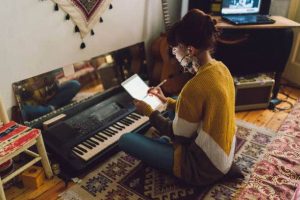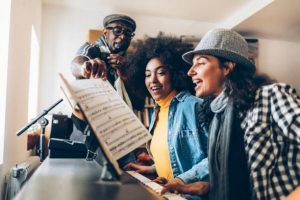Learning an instrument takes a lot of time and practice, but is a process that adds enjoyment and fulfillment to your life. To be a well-rounded musician and take your performance skills to the next level, it is important to take time and learn about the other facets of music besides your own instrument.
That’s right. Taking music lessons and studying music is critical, but there’s more to it than that. Let’s look at some of the things you need to learn in order to truly learn your craft.
Important Skills to Learn When Studying Music
- music theory: how music works and how to better analyze and understand the pieces you play
- music history: the style and background to each piece you play and how it fits into the history of music as a whole
- composition: the best way to get into a composer’s head is to compose music yourself!
- improvisation: music is a living art, and should involve creation as much as repetition
- applied literature: this involves knowing the body of repertoire available for your instrument, which is like a survey of the music history for your particular field
- dalcroze: this genre is not readily available, but is an amazing learning tool for young and beginner musicians
- masterclasses: what better way to learn than to watch someone else’s lesson?
Below is a more in-depth look into each of these topics, how they add to your musicianship, and how to get started learning about them.
1. Music Theory
Music theory is the study of how music works. This includes learning notes, rhythm exercises, and sightreading exercises to the theory behind scales, chord progressions, and harmonization. There is also musical analysis involved such as understanding the structure of pieces, counterpoint, and writing in harmonies. Furthermore, one learns dictation through rhythmic, melodic, and harmonic dictation.
Theory is an integral part of composition, as composers must understand how music works in order to write music. As performers, understanding these aspects will improve our own analysis of our pieces, and is necessary to begin developing your own interpretation on pieces.
If your teacher does not teach theory, the piano methods books by Faber (Piano Adventures), Bastien, and Alfred all offer Theory books that follow along with the various lesson levels.
2. Music History
Music history is a study of styles and trends from past to present. Learning a piece is not just about playing notes, but playing them in the right manner that fits the time period and wish of the composer. Just like clothing trends changing over time, making sure you are stylistically accurate is important in playing the piece well.
Many advanced pieces also have a history, such as who it was dedicated for, what it meant to the composer, and maybe even political or social connections. These are all important to know to have a deeper understanding of the pieces you play.
Grab a complete music history book like Norton Anthology of Western Music (by J. Peter Burkholder) to begin your journey.
3. Composition
What better way to understand a piece than to understand the person who composed it and how they composed? Learning to compose teaches us how to be creative and make new music. It also teaches us what we like or prefer in music, and helps us think of different ways to express our thoughts through music. By trying it ourselves, we can better understand how the composers of our pieces tried to convey their thoughts to paper.
Grab some staff paper and start by writing melodies that come to mind. Just the way writers brainstorm a story, one starts composing by doing a little every day. It will help to have an advanced understanding of theory, but who says you cannot compose what you like?
4. Improvisation
Improvisation is about adding variation or creating something new on the spot, much like composition. In the past centuries, these two were closely linked and often hard to distinguish which came first. The great composer and pianist Wolfgang Amadeus Mozart, for example, often improvised the piano part to his concertos, and only wrote the notes down AFTER the performance for pedagogical purposes or for publication.
Learning to improvise is another way to expand your ear and creativity. It is like adding spice and sauce to an otherwise plain dish. Being able to improvise also gives you confidence on-stage and can help with stage fright and nerves.
As open-ended as improvisation may seem, the great improvises of past and present actually follow a hand-book of common techniques and passagework to use (think ingredients in a dish). Knowing these methods will make improvisation less daunting, as well as an advanced knowledge of theory.
5. Applied Literature
Literature involves knowing the body of repertoire available for your particular instrument. Piano literature, for example, means knowing the various keyboard pieces composed by Scarlatti and Bach, the sonatas by Beethoven, the character pieces of Brahms, and the sonatas by Prokofiev. Each instrument has its own body of repertoire spanning from the invention of the instrument to the modern time. Understanding and learning about these works will only increase your enjoyment in learning your instrument, as there are so many amazing and wonderful pieces out there to play.
As you listen through the repertoire, note down pieces that catch your attention and draw you in. Having a “Favorites” list is great to maintain ambition and interest in learning. The pieces available for keyboard can be found by searching the names of composers throughout the history of music, or getting an anthology of music for your specific instrument.
6. Dalcroze
Dalcroze is the art of combining music with the body. Being able to feel music is very helpful to play music. Try playing a Minuet or Waltz without knowing the dance itself! It is one thing to be told that a Waltz is in three beats, and another to really feel it and know how to dance it. It simply adds another dimension to your musical journey.
Dalcroze is something that must be taught and led by a teacher, and is usually a group activity. Check out your local school or summer camps to see if they offer classes in this subject.
7. Masterclasses
There are three main ways to learn: be taught, watch others be taught, or engage in teaching yourself. We often learn more watching others because we are not in the “hot” seat! We can hear what the teacher is trying to address in the student’s playing, and it is easier to hear the differences when another is playing.
There are many masterclass recordings available on YouTube these days. Start by first searching your particular piece to see if there are recordings of public masterclasses. Once you find a teacher you particular enjoy watching, search their name to see what other repertoire they have taught.
The Art of Studying Music Has Many Facets
Studying music isn’t just about spending time playing the piano, or practicing long tones on the trumpet. It’s about learning the history of your instrument, gaining a deeper understanding of the music you’re playing, meeting and learning from other musicians, and more.
Alison Chiang


